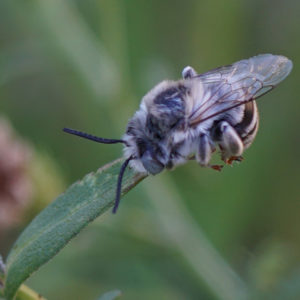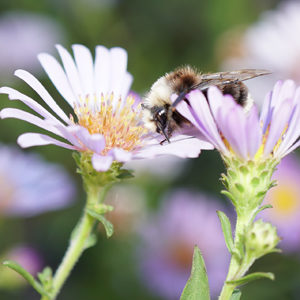
Among the several native bee species that showed up to forage for pollen and nectar in our yard this summer was the Urbane Digger bee, Anthophora urbana. The first individual I observed was working the flowers on a couple of large Cleveland Sage (Salvia clevelandii) shrubs that I planted three years ago. Cleveland Sage is fragrant, drought tolerant after it is established and native to California.

The two shrubs now regularly measure just short of five feet in height by four feet wide when the flower stalks are set and the blooming begins. With three or more clusters per stalk, individual flowers within a cluster bloom sequentially, extending the bloom period well into fall. This strategy may benefit the plant species as well as its pollinators, first by extending the length of time and fertility during which plant pollination may occur, and second by providing a steady food source from June into at least September.

For a week or more in August, I noticed a pair of male Urbane Diggers settling themselves on the spent buds and leaf tips of Symphyotrichum chilensis ‘Purple Haze’, a California aster cultivar.

The Urbane Digger male does not live in a nest. It sleeps at night on the stems, leaves and flowers of forage plants. It uses its mandibles to bite into the selected anchor so that it does not fall out, or “off” of its bed.


The asters have been in the ground for a couple of seasons. During that time, they have doubled their territory in the two locations where I planted them. They are known to spread aggressively if conditions are right. Because they are so popular with the local pollinators and bloom long into the fall, I have not tried to contain the spread.

Other native bee visitors at the aster patches included the Yellow-faced bumble bee, Bombus vosnesenskii in abundance. From late July into August they foraged among the sage, asters and sunflowers.
A pair of pollen baskets filled with a yellow to red pollen nectar mixture on the hind legs is the easiest way to identify a bumble bee as a female queen or worker. I am still trying to verify whether the absence of pollen or pollen baskets on this group indicates that most if not all of the individuals observed in this group were male bees. Another clue that this transient influx of bumble bees at the asters was male: One day they stopped showing up.

Male drones and young queens or gynes, are produced near the end of the season. Both leave the nest to forage and mate. While the drone is short-lived, a gyne has the potential to hibernate underground and establish her own nest the following spring. Both workers (all female) and drones live short lives compared with a queen that is successful in establishing a nest, but even a successful queen’s lifespan is no more than a year.


Good article, good photos, thank you for giving me a better understanding of these bees.
this is a test from sucuri support analayst lou
Thanks Lou, received!
So many interesting bees ! Son said the ones on our Sage , were bopping each other when flying. Also see very tiny bees and metalic green bees.
Recall on a hiking trail, saw a sand tube ( guess they cement sand into shapes ), ~3/8″ across , we watched it and a bee came out !
Wish I knew bee names, but they are nice to watch